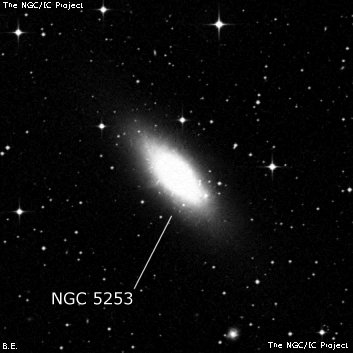
William Herschel discovered NGC 5253 = H II-638 = h3526 on 15 Mar 1787 (sweep 711) and recorded "pB, S, lE from sp to nf." His position is on the south side of the galaxy. This is the third most southerly object discovered by WH and only reached an altitude of 7° on the meridian. James Dunlop observed this galaxy on 7 May 1826 and described "a very small and very bright nebula, very much resembling a small star, surrounded by a very strong burr; this is a singular body." Dunlop made 2 observations and his position is 3' W of center. John Herschel reported it from the Cape of Good Hope as "vB, mE, psmbM, 2.5' long, 1' broad."
Z Cen = SN 1895B was the second “nova” (now known to be a supernova) to be discovered in a “spiral nebula”. It was discovered on 12 Dec 1895 by Williamina Fleming while examining a photograph of NGC 5253 taken earlier on 6 July. There was no trace of the "nova" on plates taken on 21 May to 14 June. It reached a maximum brightness of mag 8.0 before fading.
200/250mm - 8" (5/21/82): bright, elongated SW-NE, bright core.
300/350mm - 13.1" (5/26/84): bright, elongated, very bright core.
400/500mm - 18" (7/11/05 - Magellan Observatory, Australia): very bright, fairly large, very elongated 3:1 SW-NE. Very strong concentration with an intensely luminous 20" core. The outer extent increased with averted vision and faded at the tips, with overall dimensions of ~2.0'x0.7'. A very small bright knot is at the NE edge of the core and appeared similar to a nearly stellar nucleus (though offset from center), particularly using direct vision.
This small starburst galaxy is classified as a "Blue Dwarf" and harbors Super Star Clusters (SSC) near its nucleus. NGC 5253 is part of the M83/Cen A complex and lies 1.9° SSE of M83.
Notes by Steve Gottlieb